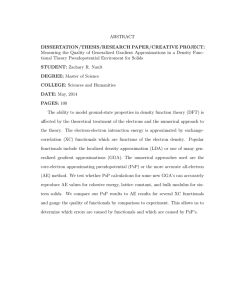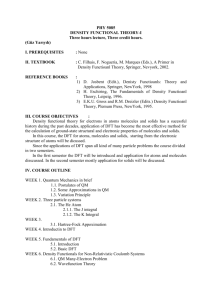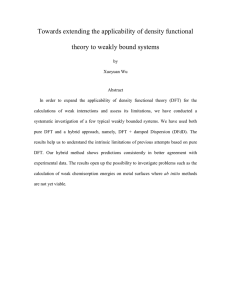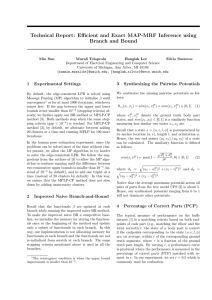WIEN2k Exchange-Correlation Methods: A Presentation
advertisement
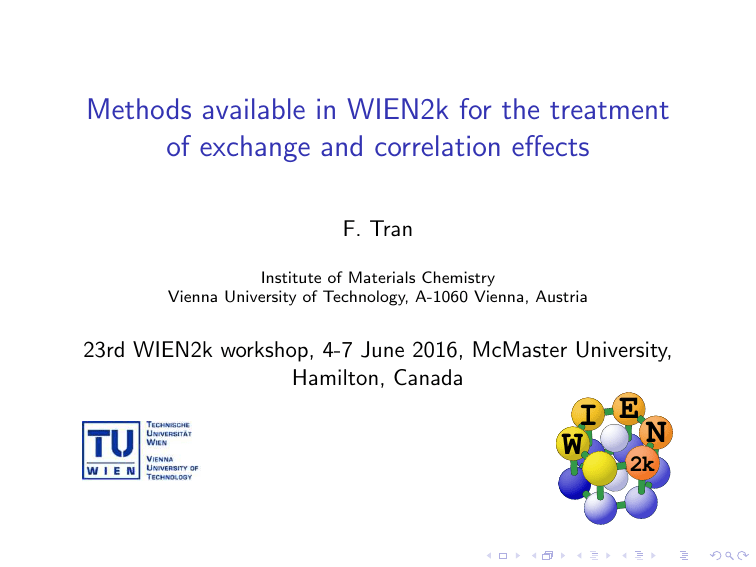
Methods available in WIEN2k for the treatment
of exchange and correlation effects
F. Tran
Institute of Materials Chemistry
Vienna University of Technology, A-1060 Vienna, Austria
23rd WIEN2k workshop, 4-7 June 2016, McMaster University,
Hamilton, Canada
I EN
W 2k
Outline of the talk
◮
◮
Introduction
Semilocal functionals:
◮
◮
◮
◮
◮
GGA and MGGA
mBJ potential (for band gap)
Input file case.in0
The DFT-D3 method for dispersion
On-site methods for strongly correlated electrons:
◮
◮
DFT+U
Hybrid functionals
◮
Hybrid functionals
◮
GW
Total energy in Kohn-Sham DFT
Etot
=
1
Z
Z
Z Z
ρ(r)ρ(r′ ) 3 3 ′
1
1X
+
ven (r)ρ(r)d 3 r
|∇ψi (r)|2 d 3 r +
d
rd
r
2 i
2
|r − r′ |
{z
}
{z
} |
|
{z
}
|
Eee
Ts
+
1 X ZA ZB
+Exc
2 A,B |RA − RB |
A6=B
|
{z
Enn
}
◮ Ts : kinetic energy of the non-interacting electrons
◮ Eee : electron-electron electrostatic Coulomb energy
◮ Een : electron-nucleus electrostatic Coulomb energy
◮ Enn : nucleus-nucleus electrostatic Coulomb energy
◮ Exc = Ex + Ec : exchange-correlation energy
Approximations for Exc have to be used in practice
=⇒ The reliability of the results depends mainly on Exc !
1
W. Kohn and L. J. Sham, Phys. Rev. 140, A1133 (1965)
Een
Approximations for Exc (Jacob’s ladder 1 )
Exc =
Z
ǫxc (r) d 3 r
The accuracy, but also the computational cost, increase when climbing up the ladder
1
J. P. Perdew et al., J. Chem. Phys. 123, 062201 (2005)
The Kohn-Sham Schrödinger equations
Minimization of Etot leads to
1
− ∇2 + vee (r) + ven (r) + v̂xc (r) ψi (r) = ǫi ψi (r)
2
Two types of v̂xc :
◮
Multiplicative: v̂xc = δExc /δρ = vxc (KS method)
◮
◮
◮
LDA
GGA
Non-multiplicative: v̂xc = (1/ψi )δExc /δψi∗ = vxc,i (generalized KS)
◮
◮
◮
◮
◮
Hartree-Fock
LDA+U
Hybrid (mixing of GGA and Hartree-Fock)
MGGA
Self-interaction corrected (Perdew-Zunger)
Semilocal functionals: trends with GGA
LDA
ǫGGA
(ρ)Fxc (rs , s)
xc (ρ, ∇ρ) = ǫx
where Fxc is the enhancement factor and
rs =
s=
1
1/3
4
3 πρ
|∇ρ|
2 (3π 2 )1/3 ρ4/3
(Wigner-Seitz radius)
(inhomogeneity parameter)
There are two types of GGA:
◮
Semi-empirical: contain parameters fitted to accurate (i.e.,
experimental) data.
◮
Ab initio: All parameters were determined by using
mathematical conditions obeyed by the exact functional.
Semilocal functionals: GGA
Fx (s) = ǫGGA
/ǫLDA
x
x
1.8
good for atomization energy of molecules
LDA
PBEsol
PBE
B88
1.7
1.6
good for atomization energy of solids
1.5
good for lattice constant of solids
F
x
1.4
1.3
1.2
1.1
good for nothing
1
0.9
0
0.5
1
1.5
2
inhomogeneity parameter s
2.5
3
Construction of an universal GGA: A failure
Test of functionals on 44 solids1
8
Mean absolute percentage error for cohesive energy
SG4
6
RGE2
PBE
PBEint
PBEalpha
4
2
• The accurate GGA for solids (cohesive energy/lattice constant).
They are ALL very inaccurate for the atomization of molecules
0
1
PBEsol
WC
0
0.5
1
1.5
Mean absolute percentage error for lattice constant
F. Tran et al., J. Chem. Phys. 144, 204120 (2016)
2
Semilocal functionals: meta-GGA
ǫMGGA
(ρ, ∇ρ, t) = ǫLDA
xc
xc (ρ)Fxc (rs , s, α)
where Fxc is the enhancement factor and
◮ α = t−tW
tTF
◮
◮
◮
α = 1 where the electron density is uniform
α = 0 in one- and two-electron regions
α ≫ 1 between closed shell atoms
=⇒ MGGA functionals are more flexible
Example: SCAN1 is
◮
as good as the best GGA for atomization energies of molecules
◮
as good as the best GGA for lattice constant of solids
1
J. Sun et al., Phys. Rev. Lett. 115, 036402 (2015)
Semilocal functionals: meta-GGA
Fx (s, α) = ǫMGGA
/ǫLDA
x
x
1.6
LDA
PBE
PBEsol
SCAN (α=0)
SCAN (α=1)
SCAN (α=5)
1.5
1.4
Fx
1.3
1.2
1.1
1
0.9
0
0.5
1
1.5
2
inhomogeneity parameter s
2.5
3
Semilocal functionals: MGGA MS2 and SCAN
Test of functionals on 44 solids1
Mean absolute percentage error for cohesive energy
8
SG4
PBEsol
WC
6
MGGA_MS2
SCAN
PBEint
RGE2
PBE
PBEalpha
4
2
• The accurate GGA for solids (cohesive energy/lattice constant).
They are ALL very inaccurate for the atomization of molecules
• MGGA_MS2 and SCAN are very accurate for the atomization of molecules
0
1
0
0.5
1
1.5
Mean absolute percentage error for lattice constant
F. Tran et al., J. Chem. Phys. 144, 204120 (2016)
2
Semilocal potential for band gap: modified Becke-Johnson
◮
Standard LDA and GGA functionals underestimate the band gap
◮
Hybrid and GW are much more accurate, but also much more
expensive
◮
A cheap alternative is to use the modified Becke-Johnson (mBJ)
potential: 1
r s
1
5 t(r)
vxmBJ (r) = cvxBR (r) + (3c − 2)
π 6 ρ(r)
where vxBR is the Becke-Roussel potential, t is the kinetic-energy
density and c is given by
p
Z
1
|∇ρ(r)|
c =α+β
d 3r
Vcell
ρ(r)
cell
mBJ is a MGGA potential
1
F. Tran and P. Blaha, Phys. Rev. Lett. 102, 226401 (2009)
4
2
6
0
2
4
Ar
LiF
C
AlN
ZnS
8
NiO
6
Xe
10
8
LiCl
MgO
12
Kr
14
GaN
ZnO
MnO
16
SiC FeO AlP CdS
Ge ScN
Si
GaAs
BN
Theoretical band gap (eV)
Band gaps with mBJ
LDA
mBJ
HSE
G0W0
GW
0
Experimental band gap (eV)
10
12
14
16
How to run a calculation with the mBJ potential?
1. init lapw (choose LDA or PBE)
2. init mbj lapw (create/modify files)
2.1 automatically done: case.in0 modified and case.inm vresp
created
2.2 run(sp) lapw -i 1 -NI (creates case.r2v and case.vrespsum)
2.3 save lapw
3. init mbj lapw and choose one of the parametrizations:
0:
1:
2:
3:
Original mBJ values1
New parametrization2
New parametrization for semiconductors2
Original BJ potential3
4. run(sp) lapw ...
1
2
3
F. Tran and P. Blaha, Phys. Rev. Lett. 102, 226401 (2009)
D. Koller et al., Phys. Rev. B 85, 155109 (2012)
A. D. Becke and E. R. Johnson, J. Chem. Phys. 124, 221101 (2006)
Input file case.in0: keywords for the xc-functional
The functional is specified at the 1st line of case.in0. Three
different ways:
1. Specify a global keyword for Ex , Ec , vx , vc :
◮
TOT XC NAME
2. Specify a keyword for Ex , Ec , vx , vc individually:
◮
TOT EX NAME1 EC NAME2 VX NAME3 VC NAME4
3. Specify keywords to use functionals from LIBXC1 :
◮
◮
TOT XC TYPE X NAME1 XC TYPE C NAME2
TOT XC TYPE XC NAME
where TYPE is the family name: LDA, GGA or MGGA
1
M. A. L. Marques et al., Comput. Phys. Commun. 183, 2272 (2012)
http://www.tddft.org/programs/octopus/wiki/index.php/Libxc
Input file case.in0: examples with keywords
◮
PBE:
TOT XC PBE
or
TOT EX PBE EC PBE VX PBE VC PBE
or
TOT XC GGA X PBE XC GGA C PBE
◮
mBJ (with LDA for the xc-energy):
TOT XC MBJ
◮
MGGA MS2:
TOT XC MGGA MS 0.504
0.14601
4.0}
{z
|
κ,c,b
All available functionals are listed in tables of the UG. and in
$WIENROOT/SRC lapw0/xc funcs.h for LIBXC (if installed)
Dispersion methods for DFT
Problem with semilocal functionals:
◮
They do not include London dispersion interactions
◮
Results are qualitatively wrong for systems where dispersion
plays a major role
Two common dispersion methods for DFT:
◮
Pairwise term1 :
PW
Ec,disp
=−
X
X
A<B n=6,8,10,...
◮
2
CnAB
n
RAB
Nonlocal term2 :
NL
Ec,disp
1
fndamp (RAB )
1
=
2
Z Z
ρ(r)φ(r, r′ )ρ(r′ )d 3 rd 3 r ′
S. Grimme, J. Comput. Chem. 25, 1463 (2004)
M. Dion et al., Phys. Rev. Lett. 92, 246401 (2004)
The DFT-D3 method1 in WIEN2k
◮
Features of DFT-D3:
◮
◮
◮
◮
◮
◮
Installation:
◮
◮
◮
◮
◮
1
Very cheap (pairwise)
CnAB depend on positions of the nuclei (via coordination
number)
Functional-dependent parameters
Energy and forces (minimization of internal parameters)
3-body term
Not included in WIEN2k
Download and compile the DFTD3 package from
http://www.thch.uni-bonn.de/tc/index.php
copy the dftd3 executable in $WIENROOT
input file case.indftd3 (if not present a default one is copied
automatically)
run(sp) lapw -dftd3 . . .
case.scfdftd3 is included in case.scf
S. Grimme et al., J. Chem. Phys. 132, 154104 (2010)
The DFT-D3 method: the input file case.indftd3
Default (and recommended) input file:
method
bj
damping function fndamp
func
grad
pbc
abc
cutoff
cnthr
num
default
yes
yes
yes
95
40
no
the one in case.in0∗
forces
periodic boundary conditions
3-body term
interaction cutoff
coordination number cutoff
numerical gradient
default will work for PBE, PBEsol, BLYP and TPSS. For other
functionals, the functional name has to be specified (see dftd3.f of
DFTD3 package)
∗
The DFT-D3 method: hexagonal BN1
2
PBE
BLYP
PBE+D3
BLYP+D3
1.8
1.4
exp
Total energy (mRy/cell)
1.6
1.2
1
0.8
0.6
0.4
0.2
0
1
3
3.2
3.4
3.6
3.8
4
4.2
Interlayer distance (Å)
F. Tran et al., J. Chem. Phys. 144, 204120 (2016)
4.4
4.6
4.8
5
Strongly correlated electrons
Problem with semilocal functionals:
◮
They give qualitatively wrong results for solids which contain
localized 3d or 4f electrons
◮
◮
◮
The band gap is too small or even absent like in FeO
The magnetic moments are too small
Wrong ground state
Why?
◮
The strong on-site correlations are not correctly accounted for
by semilocal functionals.
(Partial) solution to the problem:
◮ Combine semilocal functionals with Hartree-Fock theory:
◮
◮
DFT+U
Hybrid
Even better:
◮
LDA+DMFT (DMFT codes using WIEN2k orbitals as input
exist)
On-site DFT+U and hybrid methods in WIEN2k
◮
◮
◮
For solids, the hybrid functionals are computationally very
expensive.
In WIEN2k the on-site DFT+U 1 and on-site hybrid2,3
methods are available. These methods are approximations of
the Hartree-Fock/hybrid methods
Applied only inside atomic spheres of selected atoms and
electrons of a given angular momentum ℓ.
On-site methods → As cheap as LDA/GGA.
1
2
3
V. I. Anisimov et al., Phys. Rev. B 44, 943 (1991)
P. Novák et al., Phys. Stat. Sol. (b) 243, 563 (2006)
F. Tran et al., Phys. Rev. B 74, 155108 (2006)
DFT+U and hybrid exchange-correlation functionals
The exchange-correlation functional is
DFT+U/hybrid
DFT
Exc
= Exc
[ρ] + E onsite [nmm′ ]
where nmm′ is the density matrix of the correlated electrons
◮
For DFT+U both exchange and Coulomb are corrected:
DFT
E onsite = ExHF + ECoul − ExDFT − ECoul
|
{z
} |
{z
}
correction
double counting
There are several versions of the double-counting term
◮
For the hybrid methods only exchange is corrected:
E onsite = αExHF − αExLDA
| {z } | {z }
corr.
where α is a parameter ∈ [0, 1]
d. count.
How to run DFT+U and on-site hybrid calculations?
1. Create the input files:
◮
◮
case.inorb and case.indm for DFT+U
case.ineece for on-site hybrid functionals (case.indm created
automatically):
2. Run the job (can only be run with runsp lapw):
◮
◮
LDA+U: runsp lapw -orb . . .
Hybrid: runsp lapw -eece . . .
For a calculation without spin-polarization (ρ↑ = ρ↓ ):
runsp c lapw -orb/eece . . .
Input file case.inorb
LDA+U applied to the 4f electrons of atoms No. 2 and 4:
1 2 0
PRATT,1.0
2 1 3
4 1 3
1
0.61 0.07
0.61 0.07
nmod, natorb, ipr
mixmod, amix
iatom, nlorb, lorb
iatom, nlorb, lorb
nsic (LDA+U(SIC) used)
U J (Ry)
U J (Ry)
nsic=0 for the AMF method (less strongly correlated electrons)
nsic=1 for the SIC method
nsic=2 for the HMF method
Input file case.ineece
On-site hybrid functional PBE0 applied to the 4f electrons of
atoms No. 2 and 4:
-12.0 2
2 1 3
4 1 3
HYBR
0.25
emin, natorb
iatom, nlorb, lorb
iatom, nlorb, lorb
HYBR/EECE
fraction of exact exchange
SCF cycle of DFT+U in WIEN2k
lapw0
DFT
→ vxc,σ
+ vee + ven (case.vspup(dn), case.vnsup(dn))
orb -up
↑
→ vmm
′ (case.vorbup)
orb -dn
↓
→ vmm
′ (case.vorbdn)
lapw1 -up -orb
↑
→ ψnk
, ǫ↑nk (case.vectorup, case.energyup)
lapw1 -dn -orb
↓
→ ψnk
, ǫ↓nk (case.vectordn, case.energydn)
lapw2 -up
→ ρ↑val (case.clmvalup)
lapw2 -dn
→ ρ↓val (case.clmvaldn)
lapwdm -up
↑
→ nmm
′ (case.dmatup)
lapwdm -dn
↓
→ nmm
′ (case.dmatdn)
lcore -up
→ ρ↑core (case.clmcorup)
lcore -dn
→ ρ↓core (case.clmcordn)
mixer
σ
→ mixed ρσ and nmm
′
Hybrid functionals
◮ On-site hybrid functionals can be applied only to localized electrons
◮ Full hybrid functionals are necessary (but expensive) for solids with
delocalized electrons (e.g., in sp-semiconductors)
Two types of full hybrid functionals available in WIEN2k1 :
◮
unscreened:
DFT
Exc = Exc
+ α ExHF − ExDFT
◮
screened (short-range),
1
|r−r′ |
→
′
e −λ|r−r |
|r−r′ | :
DFT
Exc = Exc
+ α ExSR−HF − ExSR−DFT
screening leads to faster convergence with k-points sampling
1
F. Tran and P. Blaha, Phys. Rev. B 83, 235118 (2011)
Hybrid functionals: technical details
◮
10-1000 times more expensive than LDA/GGA
◮
k-point and MPI parallelization
Approximations to speed up the calculations:
◮
◮
◮
◮
Underlying functionals for unscreened and screend hybrid:
◮
◮
◮
◮
◮
◮
◮
Reduced k-mesh for the HF potential. Example:
For a calculation with a 12 × 12 × 12 k-mesh, the reduced
k-mesh for the HF potential can be:
6 × 6 × 6, 4 × 4 × 4, 3 × 3 × 3, 2 × 2 × 2 or 1 × 1 × 1
Non-self-consistent calculation of the band structure
LDA
PBE
WC
PBEsol
B3PW91
B3LYP
Use run bandplothf lapw for band structure
Hybrid functionals: input file case.inhf
Example for YS-PBE0 (similar to HSE06 from Heyd, Scuseria and Ernzerhof1 )
0.25
T
0.165
20
6
3
3
1d-3
fraction α of HF exchange
screened (T, YS-PBE0) or unscreened (F, PBE0)
screening parameter λ
number of bands for the 2nd Hamiltonian
GMAX
lmax for the expansion of orbitals
lmax for the product of two orbitals
radial integrals below this value neglected
Important: The computational time will depend strongly on the
number of bands, GMAX, lmax and the number of k-points
1
A. V. Krukau et al., J. Chem. Phys. 125, 224106 (2006)
How to run hybrid functionals?
1. init lapw
2. Recommended: run(sp) lapw for the semilocal functional
3. save lapw
4. init hf lapw (this will create/modify input files)
4.1 adjust case.inhf according to your needs
4.2 reduced k-mesh for the HF potential? Yes or no
4.3 specify the k-mesh
5. run(sp) lapw -hf (-redklist) (-diaghf) ...
SCF cycle of hybrid functionals in WIEN2k
lapw0 -grr
→ vxDFT (case.r2v), αExDFT (:AEXSL)
lapw0
DFT + v + v
→ vxc
ee
en (case.vsp, case.vns)
lapw1
DFT , ǫDFT (case.vector, case.energy)
→ ψnk
nk
lapw2
→
hf
P
DFT
nk ǫnk
(:SLSUM)
→ ψnk , ǫnk (case.vectorhf, case.energyhf)
lapw2 -hf
→ ρval (case.clmval)
lcore
→ ρcore (case.clmcor)
mixer
→ mixed ρ
Calculation of quasiparticle spectra from many-body theory
◮
◮
In principle the Kohn-Sham eigenvalues should be viewed as
mathematical objects and not compared directly to
experiment (ionization potential and electron affinity).
The true addition and removal energies ǫi are calculated from
the equation of motion for the Green function:
◮
Z
1
− ∇2 + ven (r) + vH (r) + Σ(r, r′ , ǫi )ψi (r′ )d 3 r ′ = ǫi ψi (r)
2
The self-energy Σ is calculated from Hedin’s self-consistent
equations1 :
Z
Σ(1, 2) = i
+
G (1, 4)W (1 , 3)Γ(4, 2, 3)d(3, 4)
W (1, 2) = v (1, 2) +
1
P(1, 2) = −i
Z
Γ(1, 2, 3) = δ(1, 2)δ(1, 3) +
Z
L. Hedin, Phys. Rev. 139, A769 (1965)
Z
v (4, 2)P(3, 4)W (1, 3)d(3, 4)
G (2, 3)G (4, 2)Γ(3, 4, 1)d(3, 4)
δΣ(1, 2)
δG (4, 5)
G (4, 6)G (7, 5)Γ(6, 7, 3)d(4, 5, 6, 7)
The GW and G0 W0 approximations
◮
GW : vertex function Γ in Σ set to 1:
Σ(1, 2) = i
Z
G (1, 4)W (1+ , 3)Γ(4, 2, 3)d(3, 4) ≈ iG (1, 2+ )W (1, 2)
Σ(r, r′ , ω) =
G (r, r′ , ω) =
◮
i
2π
Z
∞
′
G (r, r′ , ω + ω ′ )W (r, r′ , ω ′ )e −iδω dω ′
−∞
∞
X
ψi (r)ψi∗ (r′ )
ω
− ǫi − iηi
i=1
W (r, r′ , ω) =
Z
v (r, r′′ )ǫ−1 (r′′ , r′ , ω)d 3 r ′′
G0 W0 (one-shot GW ):
G and W are calculated using the Kohn-Sham orbitals and
eigenvalues. 1st order perturbation theory gives
KS
KS
KS
ǫGW
= ǫKS
+ Z (ǫKS
i
i
i )hψi |ℜ(Σ(ǫi )) − vxc |ψi i
A few remarks on GW
◮
GW calculations require very large computational ressources
◮
G and W depend on all (occupied and unoccupied) orbitals
(up to parameter emax in practice)
◮
GW is the state-of-the-art for the calculation of (inverse)
photoemission spectra, but not for optics since excitonic
effects are still missing in GW (BSE code from R. Laskowski)
◮
GW is more accurate for systems with weak correlations
FHI-gap: a LAPW GW code1
◮
Based on the FP-LAPW basis set
◮
Mixed basis set to expand the GW -related quantities
◮
Interfaced with WIEN2k
◮
G0 W0 , GW0 @LDA/GGA(+U)
◮
Parallelized
◮
http://www.chem.pku.edu.cn/jianghgroup/codes/fhi-gap.html
1
H. Jiang et al., Comput. Phys. Comput. 184, 348 (2013)
Flowchart of FHI-gap
How to run the FHI-gap code?
1. Run a WIEN2k SCF calculation (in w2kdir)
2. In w2kdir, execute the script gap init to prepare the input files
for GW :
gap init -d <gwdir> -nkp <nkp> -s 0/1/2 -orb -emax <emax>
3. Eventually modify gwdir.ingw
4. Execute gap.x or gap-mpi.x in gwdir
5. Analyse the results from:
5.1 gwdir.outgw
5.2 the plot of the DOS/band structure generated by gap analy
Parameters to be converged for a GW calculation
◮
Usual WIEN2k parameters:
◮
◮
◮
Size of the LAPW basis set (RKmax )
Number of k-points for the Brillouin zone integrations
GW -specific parameters:
◮
◮
◮
Size of the mixed basis set
Number of unoccupied states (emax)
R
Number of frequencies ω for the calculation of Σ = GWdω
4
2
6
0
2
4
Ar
LiF
C
AlN
ZnS
8
NiO
6
Xe
10
8
LiCl
MgO
12
Kr
14
GaN
ZnO
MnO
16
SiC FeO AlP CdS
Ge ScN
Si
GaAs
BN
Theoretical band gap (eV)
Band gaps
LDA
mBJ
HSE
G0W0
GW
0
Experimental band gap (eV)
10
12
14
16
Some recommendations
Before using a method or a functional:
◮ Read a few papers concerning the method in order to know
◮
◮
◮
◮
why it has been used
for which properties or types of solids it is supposed to be
reliable
if it is adapted to your problem
Do you have enough computational ressources?
◮
hybrid functionals and GW require (substantially) more
computational ressources (and patience)

